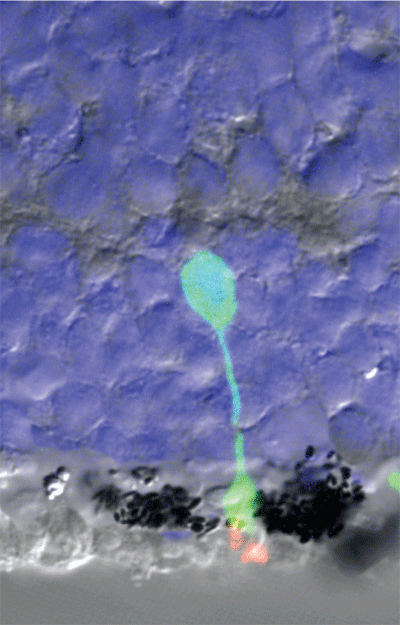For the first time, researchers in Britain have successfully transplanted retinal stem cells into mature mice with photoreceptor loss, allowing the mice to regain some vision.
The mature retina, previously believed to have no capacity for repair, is in fact able to support the development of new functional photoreceptors, the researchers say.
For the transplant, the researchers decided against using undifferentiated stem cells and instead harvested cells that had just begun to differentiate into retinal photoreceptor cells. The researchers isolated these precursor cells, hoping that their developmental level would allow them to integrate into the mature retinasomething early-stage stem cells have not been able to do.
 |
| High-power image shows a single transplanted photorceceptor cell in contact with dark pigment granules of the host retina. These granules absorb stray light and help to improve the image quality. The light-sensitive compartments of the photoreceptor (known as discs) can also be seen in red. The fluorescent green color identifies the transplanted cells. The host retinal cells are shown in blue. |
The researchers harvested the precursor cells from three- to five-day-old mice and transplanted them into the retinas of older mice with genetically-induced photoreceptor loss. The new cells not only survived, but also developed into rod photoreceptors and connected to neurons, providing visual signals to the brain. The new retinal cells were functional for the duration of the study, and improvements in pupillary and nervous response to light stimuli were recorded.
To attain these results in the human retina, fetal precursor cells would need to be harvested. Rather than use fetal cells, however, researchers point to a cluster of cells on the edge of the retina that function similarly.
A population of cells can be found on the margin of the adult retina which have stem cell-like propertiesin other words, they are capable of self-renewal. These could be harvested through minor surgery and grown in the lab to become photoreceptor precursors before being re-implanted on the retina, Dr. Ali says.
The researchers say that this transplant could have positive effects against age-related macular degeneration or retinitis pigmentosa, but they warn that any human application of this treatment is at least five years away.
MacLaren RE, Pearson RA, MacNeil A, et al. Retinal repair by transplantation of photoreceptor precursors. Nature. 2006 Nov 9;444(7116):203-7.

